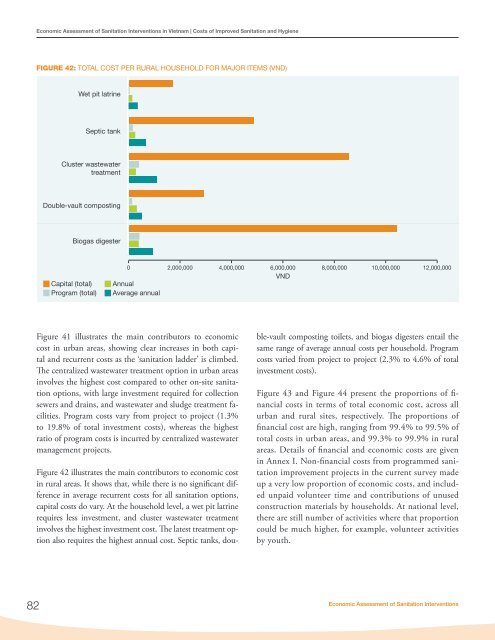Economic Assessment of Sanitation Interventions in Vietnam - WSP
Economic Assessment of Sanitation Interventions in Vietnam - WSP
Economic Assessment of Sanitation Interventions in Vietnam - WSP
Create successful ePaper yourself
Turn your PDF publications into a flip-book with our unique Google optimized e-Paper software.
<strong>Economic</strong> <strong>Assessment</strong> <strong>of</strong> <strong>Sanitation</strong> <strong>Interventions</strong> <strong>in</strong> <strong>Vietnam</strong> | Costs <strong>of</strong> Improved <strong>Sanitation</strong> and HygieneFIGURE 42: TOTAL COST PER RURAL HOUSEHOLD FOR MAJOR ITEMS (VND)Wet pit latr<strong>in</strong>eSeptic tankCluster wastewatertreatmentDouble-vault compost<strong>in</strong>gBiogas digesterCapital (total)Program (total)0 2,000,000 4,000,000 6,000,000 8,000,000 10,000,000 12,000,000VNDAnnualAverage annualFigure 41 illustrates the ma<strong>in</strong> contributors to economiccost <strong>in</strong> urban areas, show<strong>in</strong>g clear <strong>in</strong>creases <strong>in</strong> both capitaland recurrent costs as the ‘sanitation ladder’ is climbed.The centralized wastewater treatment option <strong>in</strong> urban areas<strong>in</strong>volves the highest cost compared to other on-site sanitationoptions, with large <strong>in</strong>vestment required for collectionsewers and dra<strong>in</strong>s, and wastewater and sludge treatment facilities.Program costs vary from project to project (1.3%to 19.8% <strong>of</strong> total <strong>in</strong>vestment costs), whereas the highestratio <strong>of</strong> program costs is <strong>in</strong>curred by centralized wastewatermanagement projects.Figure 42 illustrates the ma<strong>in</strong> contributors to economic cost<strong>in</strong> rural areas. It shows that, while there is no significant difference<strong>in</strong> average recurrent costs for all sanitation options,capital costs do vary. At the household level, a wet pit latr<strong>in</strong>erequires less <strong>in</strong>vestment, and cluster wastewater treatment<strong>in</strong>volves the highest <strong>in</strong>vestment cost. The latest treatment optionalso requires the highest annual cost. Septic tanks, double-vaultcompost<strong>in</strong>g toilets, and biogas digesters entail thesame range <strong>of</strong> average annual costs per household. Programcosts varied from project to project (2.3% to 4.6% <strong>of</strong> total<strong>in</strong>vestment costs).Figure 43 and Figure 44 present the proportions <strong>of</strong> f<strong>in</strong>ancialcosts <strong>in</strong> terms <strong>of</strong> total economic cost, across allurban and rural sites, respectively. The proportions <strong>of</strong>f<strong>in</strong>ancial cost are high, rang<strong>in</strong>g from 99.4% to 99.5% <strong>of</strong>total costs <strong>in</strong> urban areas, and 99.3% to 99.9% <strong>in</strong> ruralareas. Details <strong>of</strong> f<strong>in</strong>ancial and economic costs are given<strong>in</strong> Annex I. Non-f<strong>in</strong>ancial costs from programmed sanitationimprovement projects <strong>in</strong> the current survey madeup a very low proportion <strong>of</strong> economic costs, and <strong>in</strong>cludedunpaid volunteer time and contributions <strong>of</strong> unusedconstruction materials by households. At national level,there are still number <strong>of</strong> activities where that proportioncould be much higher, for example, volunteer activitiesby youth.82<strong>Economic</strong> <strong>Assessment</strong> <strong>of</strong> <strong>Sanitation</strong> <strong>Interventions</strong>
















